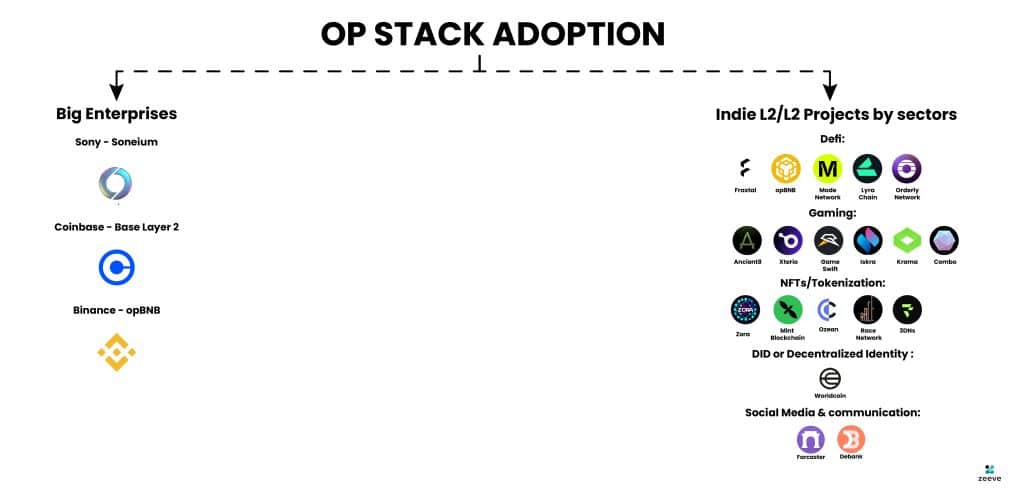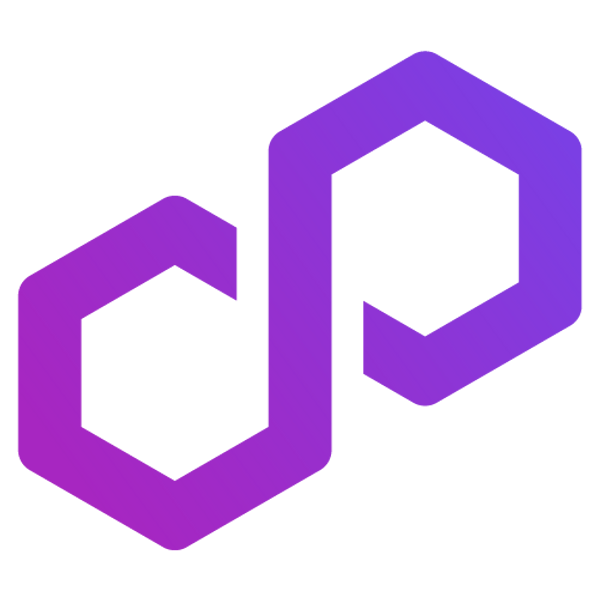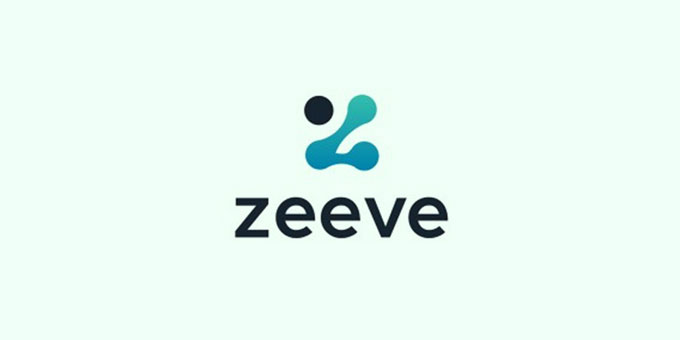OP Stack seems to be quietly winning over web3 with its future-proof innovations like Superchain, Bedrock upgrade, fault-proofs, Alt DA option, seamless interoperability, and more. If we look at statistics, Superchain contributes around 30% of total Ethereum L2 transactions of which 44% comes from OP Stack chains.
Such unparalleled growth of the OP Stack ecosystem is due to projects building across diverse sectors, from small to mid-sized and even enterprise solutions of top-fortune businesses. Through this article, we will learn about top enterprise solutions and indie solutions across diverse sectors that are benefitting from OP Stack’s comprehensive offerings.
OP Stack adoption: How it is winning across all the sectors?
The big news is about the consumer electronics giant Sony Group valued at $118B in 2024. Sony has created buzz with its next-generation Layer2 Soneium building with Optimism’s OP Stack framework. Because the project is in its very initial stage, specific information around the use-cases is yet to come. However, as per the official news shared by Sony, their Layer2 is designed to support diverse applications, ranging from finance to entertainment and gaming.
The end goal is to eliminate the challenges of Layer1 solutions and thereby deliver an ecosystem that is scalable, accessible and highly efficient to handle mass volume of traction coming from users/creators. Further, OP Stack will allow Soneium to cut down the transaction cost and significantly improve the transaction speed.
The Sony team explains that OP Stack will use their Layer2 chain to handle high-volume applications, offering an ecosystem where dApps can scale without limits. Additionally, the EVM-compatibility is creating a welcoming environment for developers to simplify creation of dApps and their corresponding smart contracts.
Now, let’s talk about what other enterprise solutions are building with OP Stack. We have Coinbase and Binance in the list at the moment:
Coinbase: Base L2
Next big biz in the list of OP Stack chains is Coinbase, valued at $8.1 Billion. In August-2023, Coinbase launched its Ethereum Layer2; Base to offer a secure, low-cost, and 100% developer-friendly rollup chain. Base quickly became popular across enterprise and web3 projects and hence Base currently has a whopping $6.33B TVL with 125+ projects and around 2.5M accounts. Also, Base contributes to more than 80% of OP Stack transactions and meanwhile contributes to 28.3% of Superchain’s total revenue.
For their Layer2, Coinbase always had the vision to leverage Optimistic rollup technology and that’s why Coinbase chose OP Stack and it’s right now the leader player. The next-level abilities of OP Stack framework allows Base to achieve 10-100X cost savings (reduction in gas fees) with EIP-4844, superfast response time, Ethereum-based security, Superchain-enabled interoperability, and most importantly high TPS of 300-400 (during peak time) which Base achieved in April, 24 without any issues. Here’s a tweet for this:
Binance: opBNB
Finally, we have Binance in the list. Binance is the leading cryptocurrency exchange valued at $80.1B and it has 185M+ active users scattered across 180+ countries. In September 13, 2023, Binance launched opBNB, a Layer2 with OP Stack to offer a high-performance, low-cost, and scalable ecosystem to dApps. opBNB currently has a TVL of $24.36M and it is home to around 20 dApps projects, including trending ones like Particle Network, Revox, DIN, CARV, etc. Powered by OP Stack, opBNB aims to achieve 4K+ TPS, average gas fee of $0.001, and 100M gas per second.
The decision to leverage the OP Stack framework came from strategic decisions and collective agreement of Binance team. As discussed, opBNB utilizes OP Stack’s vital features like EVM compatibility, high capacity, and low-cost transaction processing. However, Binance clearly explains the below reasons for OP Stack adoption:
- Flexible client execution: opBNB leverage OP Stack’s modular approach to execute smart contracts through multiple client options. This allows the opBNB chain to interact with blockchain networks in different ways to improve decentralization and overall security.
- Alternative DA option: One of the major challenges for opBNB was to guarantee that data is easily accessible and anyone can verify it. For this, OP Stack allows for separation of the DA layer off the execution Layer, which accommodates lower gas fees and makes verification really simple.
- Open-source ecosystem: opBNB leverages OP Stack’s open and fully collaborative ecosystem so that distinct projects can work together and complement each other’s growth.
Indie Solutions building across diverse sectors:
Like we discussed, OP Stack is equally feasible for all kinds of L2/L3 solutions building across diverse sectors. Hence, it’s understood what benefits OP Stack is offering for various industry sectors and the projects utilizing them:
DeFi:
OP Stack powers a wide range of DeFi L2/L3 indie solutions or we can say new projects seeking unprecedented growth and scalability. Fraxtal, opBNB, Mode Network, Lyra chain, and Orderly Network are the top DeFi chains in the OP Superchain ecosystem. The main reason for their attraction towards OP Stack framework is support for EIP-1559, transaction lost as low as 0.005 USD, Ethereum-based high-staked security, account abstraction feature, EVM-equivalence, execution flexibility, and most importantly the ability to adjust TPS to handle massive traction.
Gaming:
Though Optimistic rollups struggled initially to power gaming projects, OP Stack’s rapid adoption across gaming chains has tackled all the issues well. Some of the high-traction indie games that are building with OP Stack are Ancient8, Xterio, GameSwift, Iskra, kroma, and Combo. Speaking about OP Stack adoption, these chains enjoys full Ethereum-compatibility, 10X cheaper transaction cost with alt-DA option, open-source environment, massive scalability, seamless interoperability across Superchain ecosystem, and support for all ERC standards like ERC-4337, ERC-1155, as well as ERC-721 token standards.
NFTs/tokenization:
NFTs and asset tokenization is one of the prominent sectors where OP Stack is seeing rapid adoption. Top projects include Zora, Mint Blockchain, Ozean, Race Network, and 3DNs. OP Stack allow tokenization-based chains to leverage efficiency & ease with 100% EVM compatibility, seamless development & maintenance with open-source environment, less than 1-second transaction confirmation, low cost NFTs transaction of around $0.50, aggregated liquidity, elimination of escrow, and modularity with 3rd party integrations.
DID or Decentralized Identity:
OP Stack powers Worldcoin, a decentralized identity-focused chain having 1M+ DAU. Worldcoin manages its identity solution- World ID and Humanity’s World app; both on the OP Stack-based L2 chain. Instant access to liquidity and seamless Superchain interoperability are the main reason for Worldcoin’s adoption of OP Stack. However, Worldcoin has greatly benefited from 10x less fees and massive scalability enabled through EIP-4844 support.
Social Media & communication:
Building with OP Stack, social media and communication solutions are able to tackle the biggest challenges of centralized systems such as data breach, complex process of authentication, involvement of intermediaries, and more. Widely popular projects like Farcaster and DeBank chain are already setting new standards through utilization of OP Stack’s features like 100-400 times reduction in gas fee, high TPS to handle massive frequency of social interactions, web2-like user experience with account abstraction, fast processing, and more.

Launching your OP Stack chain? Save cost and time with Zeeve RaaS
As we can see, OP Stack is winning across all the sectors with future-proof technology and constant advancement in the stack. If you plan to build OP Stack L2/L3, Zeeve RaaS can assist you to enjoy additional benefits. With Zeeve RaaS, all types of L2/L3 OP Stack projects can save up to 60% in cost and 97% in time required to bring their chain to the mainnet. And, for your ease, Zeeve RaaS offers a one-click sandbox tool that allows you to set up a production-ready testnet with all the modular integrations and customizations. Try the sandbox yourself to check out Zeeve RaaS’ comprehensive rollup offerings. Or, you can schedule a call with our experts for a detailed discussion.























